
Monaco, officially the Principality of Monaco, is a sovereign city-state and microstate on the French Riviera a few kilometres west of the Italian region of Liguria, in Western Europe, on the Mediterranean Sea. It is a semi-enclave bordered by France to the north, east and west. The principality is home to nearly 39,000 residents as of the 2020s, of whom about 9,500 are Monégasque nationals. It is recognised as one of the wealthiest and most expensive places in the world. The official language of Monaco is French. Monégasque, English and Italian are also spoken and understood by many residents.
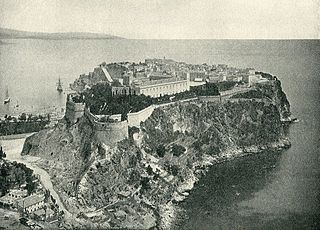
The early history of Monaco is primarily concerned with the protective and strategic value of the Rock of Monaco, the area's chief geological landmark, which served first as a shelter for ancient peoples and later as a fortress. Part of Liguria's history since the fall of the Roman Empire, from the 14th to the early 15th century the area was contested for primarily political reasons. Since that point, excepting a brief period of French occupation, it has remained steadily under the control of the House of Grimaldi.
Marquis of Baux is a subsidiary title of the prince of Monaco. When possible, the title passes from the reigning prince to the first male heir apparent or heir presumptive of the Monegasque throne.
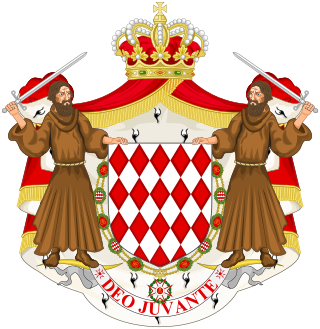
The House of Grimaldi is the reigning house of the Principality of Monaco. The house was founded in 1160 by Grimaldo Canella in Genoa and became the ruling house of Monaco when Francesco Grimaldi captured Monaco in 1297.

Monégasque is the variety of Ligurian spoken in Monaco. It is closely related to the Ligurian dialects spoken in Ventimiglia and is considered a national language of Monaco, though it is not the official language of the country, which is French. Monégasque has been officially taught in the schools of Monaco since 1972 and was made a compulsory subject in 1976, but is the native language of only a handful of people.
Duke of Valentinois is a title of nobility, originally in the French peerage. It is currently one of the many hereditary titles claimed by the Prince of Monaco despite its extinction in French law in 1949. Though it originally indicated administrative control of the Duchy of Valentinois, based around the city of Valence, the duchy has since become part of France, making the title simply one of courtesy.

The sovereign prince is the monarch and head of state of the Principality of Monaco. All reigning princes and princesses have taken the name of the House of Grimaldi. When Prince Rainier III died in 2005, he was Europe's longest reigning monarch. The Grimaldi family, which has ruled Monaco for eight centuries, is Europe's longest-ruling royal family.

Honoré II was Prince of Monaco from 1604 to 1662. He was the first to be called Prince, but started his reign as Lord of Monaco.
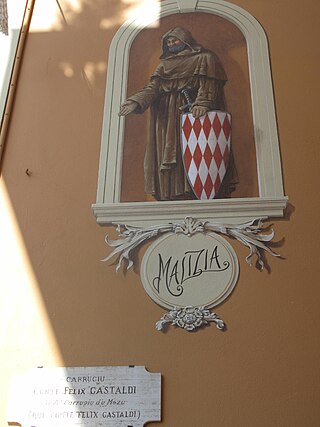
Francesco Grimaldi, called il Malizia was the Genoese leader of the Guelphs who captured the Rock of Monaco on the night of 8 January 1297. He was the son of Guglielmo Grimaldi by his wife Giacobina or Giacoba, a Genoese noble.
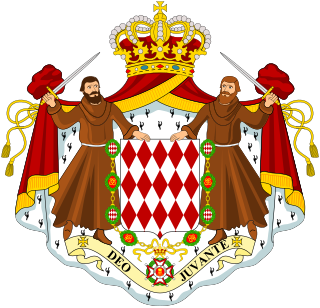
The coat of arms of Monaco, referred to also as an armorial achievement or an arms of dominion, is the symbolic representation of the House of Grimaldi, the current sovereigns of the principality of Monaco.
The Monaco succession crisis of 1918 arose because France objected to the prospect of a German national inheriting the throne of the Principality of Monaco. Prince Albert I had only one legitimate child, the Hereditary Prince Louis, then heir apparent to the principality. As World War I drew to a close, Prince Louis, at the age of forty-eight, remained without legitimate issue, unmarried, and unbetrothed.

The Treaty of Tordesillas, signed on 15 November 1524, ratified the treaty of Burgos, signed on 7 June 1524 between the Lord of Monaco and the House of Habsburg. The treaty placed Monaco under the protection of Charles V, Holy Roman Emperor and King of Spain, as an imperial fief. As a consequence, the Lord of Monaco became subservient to Charles as his vassal, marking the beginning of an Imperial and Spanish protectorate over Monaco.

The Prince's Palace of Monaco is the official residence of the Sovereign Prince of Monaco. Built in 1191 as a Genoese fortress, during its long and often dramatic history it has been bombarded and besieged by many foreign powers. Since the end of the 13th century, it has been the stronghold and home of the Grimaldi family who first captured it in 1297. The Grimaldi ruled the area first as feudal lords, and from the 17th century as sovereign princes, but their power was often derived from fragile agreements with their larger and stronger neighbours.

Lucien became Lord of Monaco on 11 October 1505, having murdered his predecessor and brother, Jean II, and held that sovereignty until his death.
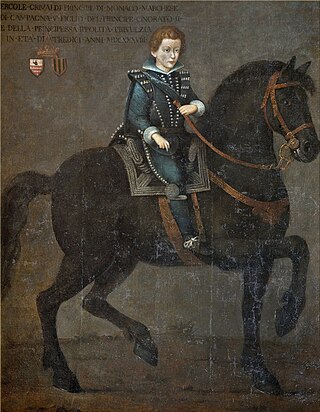
Ercole Grimaldi, Marquis of Baux was a member of the House of Grimaldi. He was the first Monegasque prince and heir apparent to the first Monegasque sovereign prince, Honoré II. Dying at the age of 27, Baux was replaced as heir apparent by his son Louis who succeeded Honoré II.

Franco-Monegasque relations are the special relationship between the French Republic and the Principality of Monaco.

Conscription in Monaco existed during a brief time between 1848 and 1870 when the Monégasque Militia was active. Since then, Monégasque citizens have been exempt both from conscription and direct taxation.

The Treaty of Stupinigi was signed on November 8 and 10 1817, in Stupinigi between Honoré V, Prince of Monaco, and Victor Emmanuel I of Sardinia.
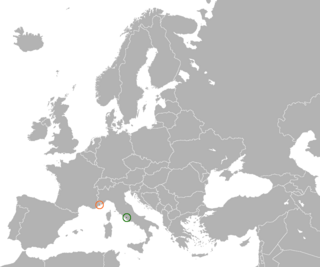
Holy See–Monaco relations are bilateral relations between the Principality of Monaco and the Holy See. The principal Monégasque official is Ambassador Claude Giordan, who officially started at his position in November 2015. The Holy See is represented by its Apostolic Nuncio, Archbishop Antonio Arcari, who assumed office on May 25, 2019. The Embassy of Monaco to the Holy See is located in Rome, on Largo Spinelli. The Apostolic Nunciature to Monaco is non-residing as the nuncio currently resides in Rome.
Aurelia Spinola (1620-1670), was a Genoese noblewoman, Princess of Monaco by her marriage to Prince Ercole, Marquis de Beaux, whom she survived after his accidental death in the use of a firearm. Their eldest son, Louis I of Monaco, became Prince of Monaco upon the death of his grandfather.


















































